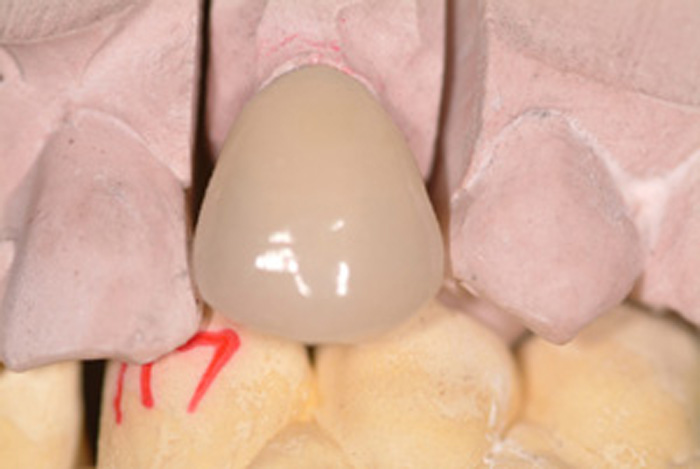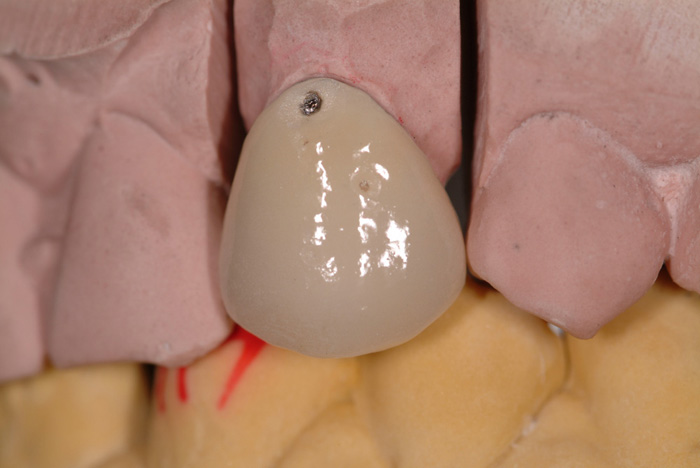Forum Replies Created
-
AuthorPosts
-
2thlaserSpectatorHere are the PFM pictures, the first one is before, obviously, the second is after. A large piece of porcelain blew off near the gingival, but you can see other areas where the porcelain was affected/removed. Now, here is a question I have for all of you. I am not well versed in the types of porcelain out there. Is there metallic fragments in some porcelain? When I removed the veneers, there was NO sparking/arcing, but with the PFM, there was arcing and sparking during the process. If there is a difference, that might be why. I will talk with my lab as well. Sorry for my ignorance to the materials issues with porcelain, but I want to discern these details. What do you all think?


Thanks,
Mark
2thlaserSpectator
Here is the second image. Sorry, it didn’t seem to upload the first time.
Mark
2thlaserSpectatorJust so you know, I sacrificed a couple of tips on that crown!!!! When it arcs/sparks, usually that means the tip is gone, and voila, there it was! Sacrificed for the sake of Laser Dentistry!

Mark
AnonymousKeymasterQUOTEQuote: from 2thlaser on 3:47 pm on Nov. 18, 2002
Just so you know, I sacrificed a couple of tips on that crown!!!! When it arcs/sparks, usually that means the tip is gone, and voila, there it was! Sacrificed for the sake of Laser Dentistry!
MarkMark, you’re not the only one – I did a little arcing and sparking with mine on a PFM also. After doing it though, I wondered why it surprised me a little, when after all I was directing the beam at something highly reflective.I’ve done the same thing removing old composite that had quartz in it so why would a PFM be different?
2thlaserSpectatorMy initial thoughts are this…IF the laser ENERGY is traveling THROUGH the porcelain, we are getting reflection back to the handpiece, spark. Another theory, is I know that there are oxides and other bimetals in PFM’s not contained in Porcelain veneers (Empress), to help with the coefficient of thermal expansion of the coping to the porcelain, keeping that bond intact between them. These are my only theories thusfar. Now, I know Bob, and Glenn will hopefully come up with other reasons, this shall be interesting………
Mark
Glenn van AsSpectatorHi there Mark……..
I have NO idea what is happening here.
WHat were your settings , how long did it take you and with or without water.
I will try this tomorrow on a crown……….
Thanks alot………..
I am stumped but dont think my Continuum can do that.
Maybe it is the porcelain………who knows.
glenn
2thlaserSpectatorHi All,
Sorry, I guess I did forget to put my settings down. I used 6W 90%air 76%water, pedal to the metal. Timewise, it took me about 10-15 seconds to produce those results. On the veneers, same thing, very quick, high settings, although I defocussed for anesthetic effect beforehand. I hope I haven’t left anything out. Please forgive me!!
Mark
lagunabbSpectatorA primary ingredient in porcelain is Kaolinite which contains Aluminum. From a U of Wisconsin site:
Kaolinite is a clay mineral with the chemical composition Al2Si2O5(OH)4. The basic building blocks are layers of silica tetrahedra (with four apical O) and layers of alumina octahedra (with two apical O shared with silica and four apical OH), in a 1:1 relationship. The unit cell (5.14 Å by 8.93 Å by 7.37 Å) repeats in the x and y directions to form extensive sheets in the xy plane and stacks of sheets in the z direction formed by hydrogen bonds (HO–H) between OH of the alumina of one sheet and O of the silica of the next.
2thlaserSpectatorCool, thanks Ray! Great info.
Mark
Janet CenturySpectatorUp and running about a week now and here’s what I’m thinking. Overall I like it VERY much. Very good comments from patients, especially since everyone seemed to see the segment on the news last week (“Oh wow – you actually have one of those!”) For some reason I have had NO patients with Class V’s come in this week, so I’ve been learning on Class I’s.
Had a gentleman who was ok with it – still felt it, but once he realized he was off to work without a numb lip decided he was a fan.
Kids are who they are. If they are whiners, they will whine with a laser too. Had my 12 yo whiner in, and did a shallow prep. Whined through it. At the end, she rated it a 1 or 2 on a scale of 1-10. I asked her to rate what the shot would have been; she said a 10. So, I rate this one a success, even with the whining.
But here’s my new favorite – I actually did pulp out with no anesthetic on a kindergardner. No problem.
Gonna have to give it a plus so far!
PatricioSpectatorGlenn,
I had a similar repair today on #9. I stippled the tooth surface and the remaining composite with the laser prior to my repair. Seeing your pictures confirms what I did, as it was my first repair using the laser.
Pat
Glenn van AsSpectatorAbsolutely fantastic Ray………..I know its not in all porcelains though as not all porcelains cut with my Continuum. In fact I think I will keep a list of which ones do and which ones dont.
How about we do the same with the Biolase.
Glenn
2thlaserSpectatorwill do Glenn, thanks as well.
Mark
2thlaserSpectatorHello All,
Yesterday, I was taking impressions for a lower removable partial denture. We still do a few of those around these parts, due to financial situations. I was about to make the rest preps on the mandibular teeth, using a round diamond and a high speed, when it occured to me to use the laser, on a very low setting, and viola it worked. I got real nice neat and controlled rest preps, with very little “pitting” from the lased surface. I used 1.25W 40%air, and 30%water.
Let’s hear some other uses as you discover them. I hadn’t heard of the above one yet, so I decided to post it here.
Thanks,
Mark
PS. I was very busy, so sorry, no photo on this one, but the next one!!!!;0
AnonymousKeymasterGreat idea ,Mark
Thanks for sharing.
Do you (or anyone else for that matter) understand what the relationship is between the water and the air?
i.e. Why in some instances you’d want to use more water than air or vice versa? -
AuthorPosts
